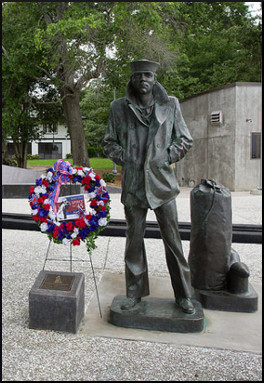
Irony is the bitter side of humor. Isn’t it funny how many military personnel survive the training and the deployment and the combat and all that goes with it – and then come back to die in the streets of the country in whose armed forces they served?
Only a few short years ago, in 2010, the federal government began requiring that homeless veterans, specifically, be counted.
Long Beach, Calif., was proud of having started a year early. The city’s homeless veterans were rather easy to count because out of a total of 846, one giant transitional housing facility housed 618 of them. Nancy Hicks wrote some details of the 2012 effort in Lincoln, Neb., which enumerated 78 homeless veterans:
The point-in-time count is taken by staff at shelters and transitional housing. The street count is taken by Lincoln police, Matt Talbot Kitchen and Outreach, Cedars Street Outreach and the U.S. Department of Veterans Affairs, with cross referencing done to identify duplicate individuals.
The government plan to house all veterans by 2015 was well underway. Steve Vogel of the Washingon Post wrote:
More than 37,000 veterans have been housed using HUD Section 8 housing vouchers, which are coupled with support from case managers and access to VA health care…The decline in veterans’ homelessness, from 67,495 in January 2011 to 62,619 in January 2012, followed a 12 percent reduction between 2010 and 2011.
The Veterans Affairs Supportive Housing (VASH) program was credited with making an impact, and the government tripled the previous year’s allotment to Supportive Services for Veterans Families, promising $300 million for 2013. The January 2013 “Point-in-Time” estimate, extrapolated with fancy formulas from incomplete data, indicated a 24% drop in veteran homelessness nationwide. Six months later in California, Gale Holland wrote:
A business group said Friday that 53,000 people, including 33,000 veterans, will join Los Angeles County’s homeless ranks by 2016, the deadline the group had set to get former soldiers and chronic transients off the streets for good.
Six months after that, USA Today reported that in 2013, nearly 50,000 military personnel back from the Afghanistan and Iraq wars were “either homeless or in a federal program aimed at keeping them off the streets,” and that number was three times what it had been in 2011. A VA spokesperson offered an interesting perspective, suggesting that the number of homeless vets from those conflicts had increased only because the VA was searching for them more diligently. A children’s advocacy organization announced that one-fourth of the people experiencing homelessness are either veteran, or the spouses or children of veterans.
Joel Blau of Stony Brook University’s School of Social Welfare compared homeless statistics to the unemployment rate. Since the number does not include people who have run out of benefits, it is really twice as high as it seems. Similarly, many people are not counted as homeless because they are in hospitals or rehab facilities or psych wards, or incarcerated, or simply living invisibly in cars.
(to be continued…)
Reactions?
Source: “Inside City Hall: Veterans to be a focus of LB homeless count,” PressTelegram.com, 12/28/10
Source: “Homeless count highest since 2006, when it started,” JournalStar.com, 10/14/12
Source: “Veteran homeless drops 7 percent, VA says,” WashingtonPost.com, 12/10/12
Source: “Task force projects 50,000 more homeless in L.A. County by 2016,” LATimes.com, 07/12/13
Source: “Homelessness surges among veterans of recent wars,” USAToday.com, 01/16/14
Source: “Homeless: More People Live on the Streets Amid Arctic Blasts than Stats Show,” LongIslandPress.com, 02/01/14
Image by North Charleston
